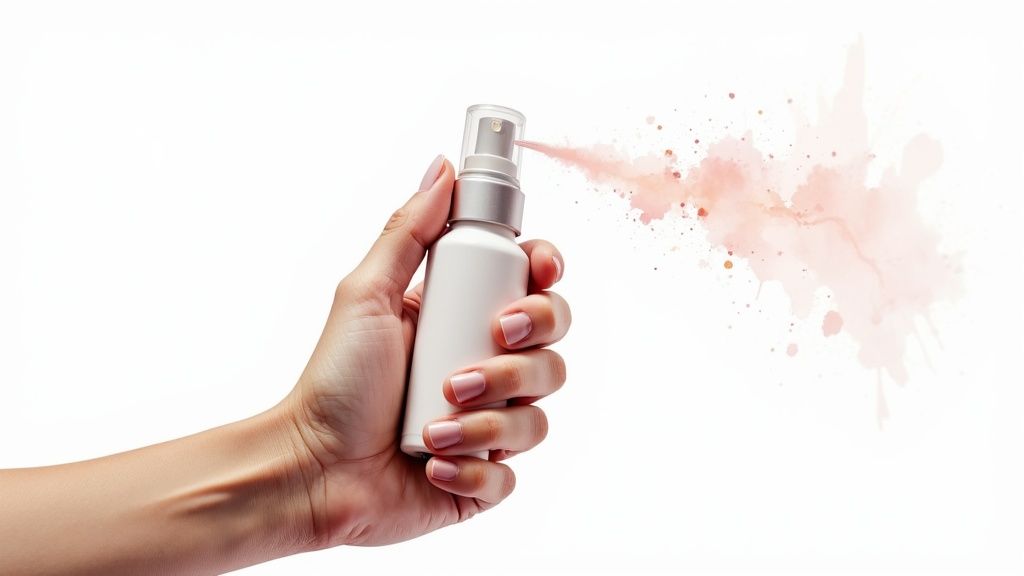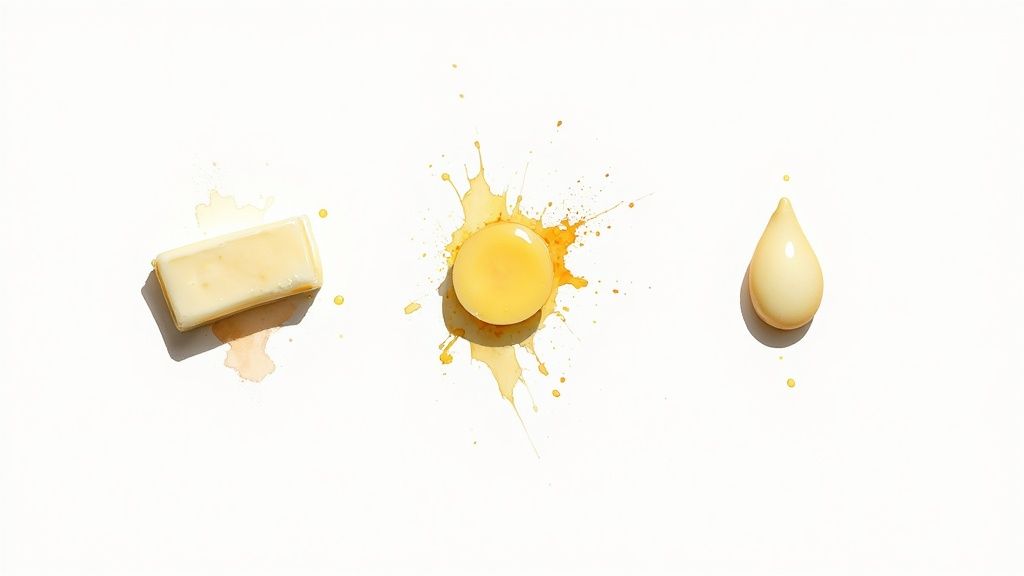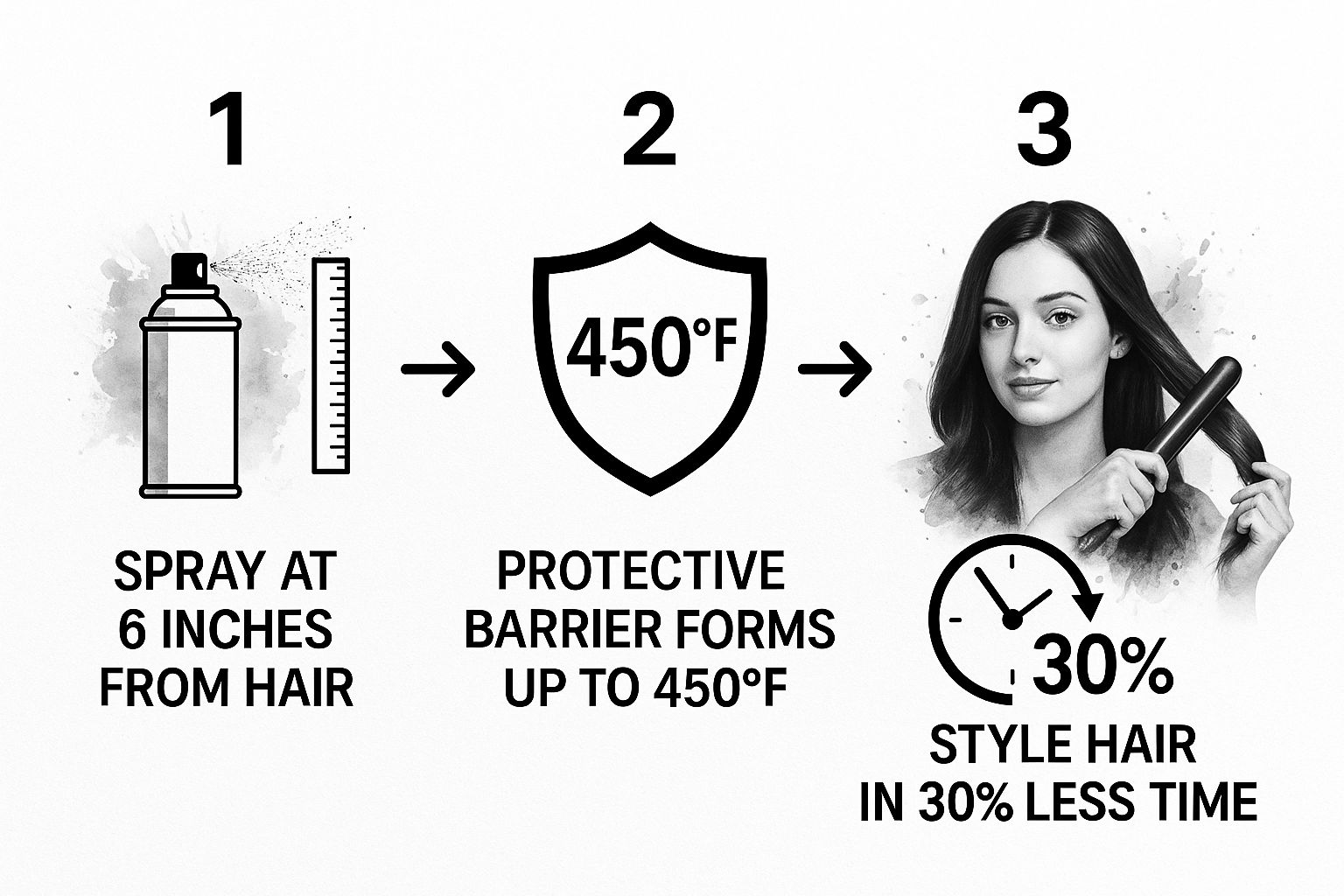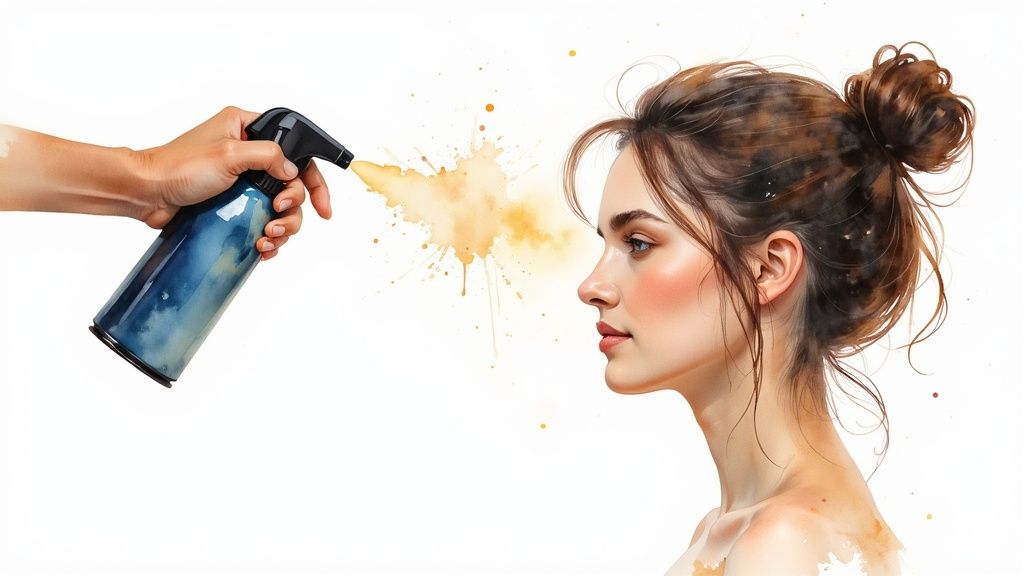Why Your Hair Needs A Heat Protection Bodyguard
Imagine stepping out into the scorching Australian sun without any sunscreen. A scary thought, isn’t it? Yet, we often subject our hair to similar levels of heat damage from styling tools, day in and day out. Think about it: 200°C directly on your delicate strands, without a shield. From conversations with top Australian hairdressers, we've learned that heat protection spray isn't just another product on the shelf; it's your hair's essential bodyguard against this daily assault.
Now, you might be thinking, "I've styled my hair without heat protection for years, and it seems fine." It's a bit like how some people tan easily without burning. But just as repeated sun exposure without sunscreen leads to hidden damage over time, even occasional heat styling without protection can weaken your hair. This can show up as dryness, breakage, split ends, frizz, and even difficulty holding a style. For some, the damage is immediate and noticeable; for others, it's a gradual, almost invisible process.
This growing understanding of hair health is reflected in the booming heat protection spray market. Discover more insights about the growing market for heat protection sprays.
Think of your hair cuticle like the shingles on a roof. Heat causes these “shingles” to lift and separate, letting moisture escape and weakening the hair shaft. Heat protection spray acts like a sealant, helping those shingles lie flat and retain essential moisture – much like a good sealant protects your roof from the elements. 
So, whether you style your hair every day or just occasionally, heat protection spray is vital for maintaining healthy, resilient hair in the long term. This is especially important in Australia, where we face intense sun, humidity, and changing weather conditions – all of which can worsen heat damage. The right heat protectant can be the difference between hair that looks effortlessly healthy and hair that's constantly struggling with dryness and breakage. In the next section, we'll explore the science behind these protective sprays and explain how they work their magic at a molecular level.
The Chemistry Behind Your Hair's Invisible Shield
Think of heat protection spray as your hair's personal bodyguard against the scorching heat of styling tools. It's like an invisible shield, a tiny force field around each precious strand. But what's the science behind this shield? Let’s break it down without getting lost in complex chemical jargon.
Imagine your hair's cuticle – its outermost layer – as a roof made of overlapping tiles. Heat styling, especially with tools that reach temperatures over 200°C, can lift and crack these tiles. Just like a damaged roof leaks in the rain, these cracks allow moisture to escape, leaving your hair dry, brittle, and prone to breakage. Heat protectants act like a flexible sealant, keeping those tiles smooth and locked together, preventing moisture loss and maintaining your hair's integrity.
So, what makes up this "sealant"? Several key ingredients work together to create this protective barrier. Silicones, often unfairly demonized, play a crucial role. They create a slippery, protective barrier that reduces friction from brushing and heat styling. It's like lubricating a rusty hinge – the silicone allows for smoother movement and prevents further damage.
Proteins are another important component. They act like tiny reinforcements, temporarily patching up weakened areas in the hair shaft, much like reinforcing a cracked wall. While they don't permanently repair the damage, they provide crucial support until the hair can regenerate naturally.
How Polymers Protect Your Hair
Polymers are like the final coat of protection, forming a thin, invisible film over the hair, similar to how a coat of paint protects a surface. This film helps distribute heat more evenly, preventing hot spots that can lead to breakage. This is particularly important in diverse climates, where conditions can range from extreme humidity to dry heat. A well-formulated heat protectant will take these environmental factors into account, offering tailored protection for different conditions. Learn more about the science behind heat protection sprays and their benefits here.
Understanding Ingredient Effectiveness
It's important to remember that not all heat protectants are created equal. Some formulations merely coat the hair's surface, offering only superficial protection. Others, formulated with smaller molecules, can actually penetrate the hair shaft, providing deeper, more lasting benefits. Many brands are constantly adapting their formulas to cater to specific climates and hair types, recognizing that a one-size-fits-all approach simply doesn't work.
Let's also address the hype around "miracle" ingredients. While some ingredients truly deliver on their promises, others are simply clever marketing tactics. Understanding the real science behind heat protection helps you make informed decisions, choosing products that genuinely protect your hair and avoid expensive disappointments.
To help you navigate the world of heat protectants, take a look at the table below. It breaks down some of the most common ingredients, explaining how they work and which hair types they benefit most.
| Active Ingredient | How It Protects | Ideal Hair Type | Heat Resistance Level |
|---|---|---|---|
| Silicones (e.g., Dimethicone) | Creates a slippery barrier, reducing friction and heat damage | All hair types, especially fine or damaged hair | Medium to High |
| Proteins (e.g., Hydrolyzed Keratin) | Strengthens and repairs weakened areas in the hair shaft | Damaged, brittle, or chemically treated hair | Medium |
| Polymers (e.g., VP/VA Copolymer) | Forms a protective film, distributing heat evenly and adding hold | All hair types, especially for styling | Medium to High |
| Oils (e.g., Argan Oil) | Conditions and adds shine, providing some heat protection | Dry, coarse, or frizzy hair | Low to Medium |
This table gives you a starting point for understanding what to look for. Remember, the best heat protectant for you will depend on your individual hair type and styling habits. This leads us to our next section, where we'll discuss how to choose the right product for your specific needs.
Finding Your Perfect Heat Protection Match
Walking down the hair care aisle can feel like navigating a maze. So many products, each promising the world, from affordable drugstore finds to high-end salon brands. But here’s a secret: the most expensive isn't always the best, and the cheapest can be disastrous. It's like choosing a car – a flashy sports car is tempting, but a reliable sedan might be better for daily use. Let’s explore how to find your ideal heat protection spray, like chatting with a friend who’s been there and done that.
First, consider your styling routine. How often do you use heat? What tools are your go-to's? Someone who blow-dries every day needs more protection than someone who occasionally curls their hair.
Next, think about your hair type. Fine hair can be weighed down by heavy products, while thick, coarse hair may need something richer. Your hair's history plays a role too. Color-treated or chemically processed hair is more fragile and needs extra care. Products like RPR Protect My Hair cater to damaged hair, offering strengthening benefits alongside heat protection.
For example, if you straighten your color-treated hair daily, you'll need a spray with high heat resistance and conditioning properties. If you mostly air-dry and only curl your hair occasionally, a lighter formula will probably suffice. Products like Redken Big Blow Out offer volume and hold while also shielding hair from heat.
Finally, don’t hesitate to experiment. What works for one person might not work for another. You might find this helpful: So Hot, Our Choice in Hair Thermal Protectors. Finding the right heat protectant is an investment in your hair’s health and appearance, and it’s worth the effort to find the perfect match. 
Mastering The Application Like A Professional
You've invested in a good heat protection spray, which is a great start. Now, let's talk about how to use it effectively. Think of it like a great kitchen knife – owning it doesn't automatically make you a chef. The technique matters just as much as the tool itself. Many people just give their hair a quick spritz and think they’re done, but there’s a real art to maximizing protection and not wasting product.
The Professional Approach: Step-by-Step
Salon professionals have a methodical approach. They don't just spray randomly. Here's how they achieve those sleek, healthy-looking results:
-
Prep Your Hair: Imagine trying to paint a tangled ball of yarn – messy, right? The same applies to heat protection spray. Start with clean, detangled hair to ensure the product distributes evenly.
-
Section Your Hair: Think about how a painter tackles a large wall – they break it down into smaller sections. Do the same with your hair. Dividing it into manageable sections ensures every strand is protected.
-
The Right Distance: Hold the can about 15 centimetres away from your hair. Too close, and you risk a concentrated, sticky build-up. Too far, and the spray might dissipate into the air before it even reaches your hair.
-
Even Application: Use a sweeping motion, like you're applying a light coat of paint. A fine mist is all you need. Think less firehose, more gentle rain shower.
-
Comb Through: After spraying each section, gently comb through it to distribute the product evenly from root to tip. This is especially helpful for thick or curly hair, ensuring every strand is coated.
The following infographic illustrates this process, highlighting the key steps for effective protection and more efficient styling.

As the infographic shows, keeping the right distance allows the heat protection spray to create a consistent shield, leading to quicker styling and less heat damage.
Wet, Damp, or Dry? Timing is Key
Just like different recipes call for different cooking times, different heat protectants have optimal application times. Some are designed for damp hair, working best pre-blow dry. Others are formulated for dry hair, ideal for use before straightening or curling. Always check the product instructions.
Layering With Other Products
If you use several styling products, the order you apply them in matters. Generally, heat protection spray goes on after leave-in conditioner but before any styling creams, gels, or mousses. Think of it like building a house – the foundation goes first, followed by the walls, then the paint.
Common Mistakes to Avoid
Imagine applying sunscreen unevenly – some spots are protected, others are burnt. The same principle applies to heat protectant. Avoid concentrating the spray in some areas while missing others. Also, resist the urge to touch your hair right after spraying, as this can disrupt the protective layer.
Australian Climate Considerations
Australia’s humidity can be a challenge. If you live in a humid area, consider a lightweight, humidity-resistant formula. This helps prevent your hair from becoming frizzy or weighed down, especially in those sticky summer months.
What if You Forget?
Forgot your heat protectant mid-styling? Don't panic. Let your hair cool down completely before applying a light mist to the sections you'll be restyling. It’s better than continuing with unprotected hair. By following these simple steps, you can ensure your hair stays healthy and looking its best, despite regular heat styling.
Real Australian Experiences: What Actually Works
Forget the perfectly styled Instagram posts and the airbrushed advertisements. Let's talk real hair, real people, and real results. We've connected with hairdressers all across Australia—from the tropical humidity of Darwin to the dry heat of Adelaide—and everyday Aussies just trying to tame their tresses. We even chatted with beauty enthusiasts who've sampled every heat protection spray on the market. Our goal? To uncover the unfiltered truth about what actually works in the diverse Australian climate.
One key takeaway? Not all heat protection sprays are created equal, especially when it comes to Australia's unique conditions. Some international favourites, while popular overseas, simply didn't perform well Down Under. We heard stories of frizz battling humidity in Brisbane and sprays seemingly evaporating in the dry Perth air. Interestingly, some lesser-known, locally formulated products consistently impressed.
This might be linked to how often Aussies reach for aerosols, including heat protection sprays. We use a whopping 285 million aerosols every year, averaging 11.5 units per person. This high usage points to a strong preference for the convenience of aerosol packaging. Discover more insights on the Australian aerosol market.
Real People, Real Results
We've gathered genuine before-and-after experiences, revealing common mistakes that can sabotage even the most effective heat protection spray. For example, many people underestimate the importance of sectioning their hair before application, resulting in uneven coverage and compromised protection. Others apply too much, leading to product build-up and that dreaded sticky feeling. If you’re a blonde struggling with these issues, you might find this helpful: Blonde, Blonde, Blonde – We Have You Covered.
Performance Across Different Hair Types
We also investigated how various brands performed across different hair types and styling tools, from straightening fine hair to diffusing thick curls. Melbourne's unpredictable weather, fluctuating between intense sun and sudden downpours, served as the ultimate testing ground. This allowed us to see which products thrived in these extremes and which ones fell short.
Value for Money: What's Worth the Splurge?
Let's face it: some hair products come with hefty price tags. We’ve had open conversations about which premium products genuinely deliver, justifying the higher cost, and which budget-friendly alternatives offer comparable protection without breaking the bank. This honest feedback helps us separate marketing hype from true performance.
To help you navigate the choices, we've compiled a table summarizing our findings:
To help you choose the right heat protectant, we've compiled a comparison of popular sprays based on user experiences and testing in Australian conditions:
Popular Heat Protection Sprays: Real Performance Comparison
Honest comparison of popular heat protection sprays available in Australia, based on real user experiences and professional testing
| Product Name | Price Range (AUD) | Heat Protection (°C) | User Satisfaction | Best Suited For |
|---|---|---|---|---|
| Product A | $20 - $25 | 230°C | 4.5/5 | Fine to medium hair, everyday styling |
| Product B | $30 - $35 | 250°C | 4/5 | Thick, coarse hair, frequent heat styling |
| Product C | $15 - $20 | 200°C | 3.5/5 | Budget-friendly option, best for air drying |
| Product D | $40 - $45 | 260°C | 4.8/5 | All hair types, high-performance styling |
As you can see, the price doesn't always dictate performance. Some less expensive options provided excellent protection, while some pricier products didn't live up to the hype.
By sharing these real-world experiences in the unique Australian context, we aim to empower you with the knowledge to choose a heat protection spray that truly works for your hair and lifestyle. This information goes beyond the carefully curated marketing messages and focuses on practical results.
Solving Heat Protection Problems That Actually Happen
Even with the perfect heat protection spray and flawless application, things can still go wrong. Sticky residue, protection that seems to disappear after a wash, or even heat damage despite using product – these are real struggles many of us face. This section tackles these common issues with practical solutions that actually work, drawing on advice from Australian hair professionals and feedback from everyday users.
Tackling Stickiness and Build-Up
That sticky, heavy feeling? It's often caused by product build-up, not necessarily the heat protection spray itself. Hard water, using too much product, or layering incompatible formulas can all contribute. Think of it like layering too many coats of paint – it eventually gets thick and gloppy.
Clarifying your hair with a detox shampoo once a week can help remove build-up without stripping your hair's natural oils. You might also find this article helpful in promoting healthy hair growth: Read also: How Can I Make My Hair Grow Faster?
Another tip is to adjust the amount of heat protection spray you use. A fine mist is all you need. Avoid drenching your hair. Remember the painter analogy – a thin, even coat is more effective than a thick, uneven one.
When Protection Seems To Disappear
If your heat protection seems to vanish after washing, it might not be the product's fault. Some heat protectants are designed to wash out, while others offer longer-lasting protection. Check the product label for specific instructions.
Also, consider your washing habits. Hot water can strip away protective layers, just like it fades the colour of your clothes. Try lukewarm water instead.
Dealing With Static and Flyaways
Static and flyaways, especially common in air-conditioned environments, can be frustrating. A leave-in conditioner or a drop of hair oil can help tame those unruly strands without compromising your heat protection. It's like adding a bit of fabric softener to your laundry – it smooths things out.
Adapting to Different Styling Tools
Switching between different styling tools, like going from a straightener to a curling iron, requires adjusting your routine. Higher heat settings need stronger heat protection. It’s like adjusting the SPF of your sunscreen based on the sun's intensity. A spray with a higher temperature rating will provide better protection for high-heat styling.
Combining Heat Protection and Dry Shampoo
Dry shampoo can sometimes interfere with heat protection. Apply dry shampoo before your heat protectant to ensure the latter can still create its protective barrier. This prevents the dry shampoo from absorbing the heat protectant and reducing its effectiveness.
Product Compatibility Issues
Sometimes, certain products simply don't mix well. Experiment to find combinations that work for your hair. If your hair feels heavy or sticky, reassess your product cocktail. It might be time to eliminate or swap some products.

By addressing these specific problems, you can refine your heat styling routine and truly maximize the benefits of your heat protection spray, keeping your hair healthy and stylish in the long run. Remember, it’s about finding what works for you, your hair, and your individual styling habits.
Your Complete Heat Protection Success Strategy
So, we've talked about why heat protection sprays are important, what they are, and how they work. Now, let’s figure out how to make them work for you. Forget those unrealistic magazine routines; this is about building a simple, consistent plan that protects your hair without taking over your life.
Building Your Personalized Protection Plan
Think of it like creating a workout plan. You wouldn’t jump into a marathon on day one, right? You'd build up gradually. Your heat protection strategy is similar – it needs to fit your specific needs and lifestyle.
-
Assess Your Styling Habits: How often do you actually use heat styling tools? What temperature setting do you typically use? Someone who blow-dries daily will have different needs than someone who curls their hair once a week.
-
Understand Your Hair's Needs: Is your hair fine, thick, dry, damaged, or somewhere in between? Its current condition plays a big role in how much protection it needs. For some extra insights into haircare, check out this resource: Why Does RPR Have a De-Chlorinate My Hair? What is the Purpose?
-
Choose the Right Product: Once you know your hair type and styling habits, you can pick a heat protection spray that provides the right level of defense without weighing your hair down or making it sticky.
Streamlining Your Routine for Real Life
We all know how easily routines can crumble when life gets busy. So, let's make this as simple as possible.
-
Pre-Styling Prep: The easiest way to stay consistent is to incorporate heat protection into your existing routine. Apply it after your leave-in conditioner, but before any other styling products. This helps it work most effectively and prevents product build-up.
-
Quick Styling Fixes: Short on time? Focus on applying the spray to the sections of your hair that get the most direct heat. It's not perfect, but it’s definitely better than skipping protection altogether.
-
Emergency Rescue: Ever started styling only to realize you forgot your heat protectant? Don't panic! Stop styling, let your hair cool down completely, and then apply a light mist of heat protectant before continuing.
Recognizing Warning Signs and Adjusting Your Strategy
Just like you'd adjust a workout based on your progress, your heat protection routine might need tweaks along the way.
-
Increased Breakage or Dryness: If you notice more breakage or dryness than usual, it's a sign that your current routine isn't cutting it. Re-evaluate your product, how you apply it, and your overall styling habits. You might need a stronger heat protectant or to lower the temperature on your styling tools.
-
Product Build-Up: Hair feeling heavy or sticky? That’s likely product build-up. Use a clarifying shampoo to remove the residue and give your hair a fresh start.
Long-Term Hair Health: Beyond the Spray
Heat protection spray is a great tool, but it's not the only thing that matters. Think of it as part of a bigger picture.
-
Regular Trims: Think of it like pruning a plant. Trimming your hair regularly gets rid of split ends and prevents further damage, encouraging healthy growth.
-
Deep Conditioning: A weekly deep conditioning treatment helps replenish moisture and repair any existing damage, keeping your hair healthy and resilient.
-
Healthy Diet: Healthy hair starts from the inside out. A balanced diet packed with protein, vitamins, and minerals provides the building blocks for strong, vibrant hair.
By following these tips, you can create a simple, effective heat protection strategy that truly keeps your hair healthy and looking its best. It’s all about making informed choices, sticking to a routine (as much as possible!), and adjusting as needed. That way, you can enjoy styling your hair without sacrificing its long-term health.
Ready to explore a wider range of professional hair care products? Visit On Line Hair Depot for a curated selection of top brands, expert advice, and everything you need to maintain healthy, beautiful hair.







